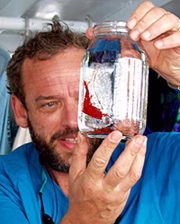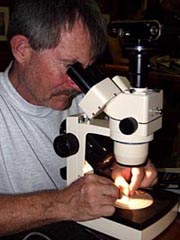Partnership, Presentation, Participation and Protection
NAI'A began in Fiji in 1993 as a passenger-supported marine mammal research vessel. With 15 seafaring years of experience and a university degree in marine mammal behaviour, Rob Barrel's concept was that while paying scuba diving guests explored underwater, sponsored on-board dolphin scientists would simultaneously identify individual animals and study pod tactics. Guests could assist the science with observations and the science would in turn educate them and enrich their experience. Meanwhile, resulting tourist income to the country and to the local communities would encourage the protection of the animals and their ocean habitat. But reality often hinders good design. In our case the enormous running costs of a ship and the tendency for good dive sites to be great distances from the dolphins' range meant NAI'A had to do what all successful species do: adapt.
Eight years on we have found various angles on eco-tourism - sometimes by design and sometimes by the opportunities of time and place. The motivation to "do the right thing" is nowadays not only our own. Our clients actively seek out vacations that enable them to understand more intimately the cultures and environments they visit as well as guard those attractions against the onslaught of indiscriminate development. As divers, our guests are inherently the most eco-aware of all travelers to the South Pacific. So, alongside our personal ideals, our divers' skills and desires have evolved NAI'A into an eco-diving destination driven by four principles: Partnership, Presentation, Participation and Protection.
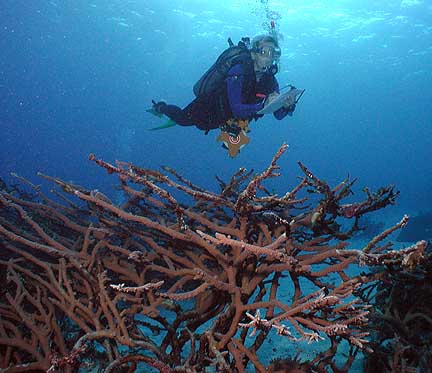 |
| Marine biologist and sometime NAI'A cruise director, Helen Sykes, records life over a coral reef transect line. |
Partnerships with individual "experts" and credible organizations are crucial. Just running a live-aboard dive boat is a huge task, let alone the work required to concoct eco-projects and carry out those plans. No matter how diligent and knowledgeable, a cruise director and crew can rarely double as marine biologists, teachers and conservationists - and do those jobs well. NAI'A teammates include several post grad marine science students from universities in Fiji, Australia and the USA as well as respected professionals such as New England Aquarium conservation biologist, Dr Gregory Stone, and research biologist, Dr Norman Quinn. We have hosted special research diving trips in conjunction with The University of the South Pacific, New England Aquarium, the South Pacific Humpback Whale Project and the World Wildlife Fund. Equally important are the long-term relationships we have with government departments in Fiji, Tonga, Vanuatu and Kiribati.
No matter how serious the science or how close the cultural encounter; good presentation is priceless in lending it meaning and relevance to tourists. Communicating well with guests has a triple whammy effect in added value:
- It educates - giving a sense of gain;
- It entertains - guaranteeing good memories;
- It inspires guests to spread the environmental word back home.
The famously friendly Fijian crew on NAI'A is as important to presentation as a formal slide show on invertebrate ecology. In English, they share stories about their lives at sea among the Pacific Islands. But they also bridge the language barrier during traditional Fijian village ceremonies and explain the meaning and history behind the rituals. Our visiting scientists/researchers are adored as much for their enthusiasm for nature and gift of the gab as for their memory for Latin fish names! In slide and video presentations we try to give each character on the reef a story - where it lives, how to find it, who are its friends and enemies, why does it behave that way?
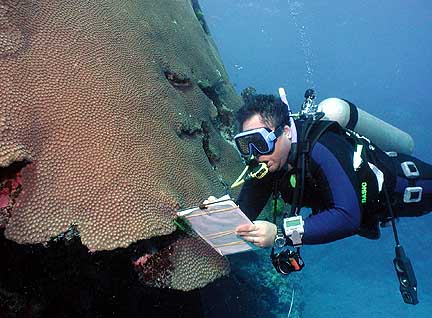 |
| Samasoni Sauni of the University of South Pacific examines coral health in Kadavu. |
The level of participation in eco-diving tours varies not only from project to project but also from person to person. In some cases it is enough for people simply to watch and ask questions. In others our guests are key players completing central tasks. For example, our depth temperature-monitoring program doesn't offer much opportunity for divers to actually do anything. But the graphic results that we print out for those who want them - and the simple equipment used - are often the impetus for much dinnertime discussion on ocean currents, weather patterns or coral bleaching. On the other hand, during our Phoenix Rising 2000 research expedition, each guest was trained in specific survey techniques and was entirely responsible for the data collected in their field (corals, invertebrates, predator fish, herbivores etc) that went onto form the bulk of the scientific papers and reports on diversity and abundance that the journey produced. Several of our passengers on Tonga Humpback Whale Expeditions contribute their identifying fluke photographs and video to the regional library of humpback whales. We often record guest divers' interesting observations or sightings in our dive log/reef database. A few NAI'A divers have spoken at village schools about marine conservation and showed video or photos of the underwater life off village shores. Many have generously donated books and other educational tools to local communities. But everyone goes home having learned some Fijian language, followed traditional customs and experienced first hand the memorable and unique flavor of Kava!
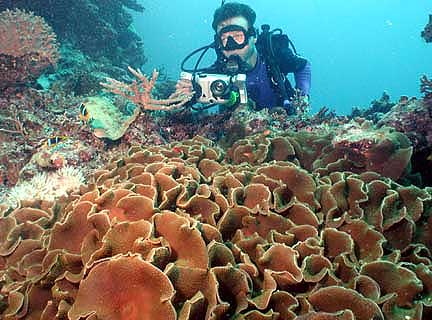 |
| NAI'A passenger and volunteer researcher records "video transects" for coral reef monitoring in Fiji. |
It is often quoted that "the only real eco-tourism is to stay at home". Certainly, without a greater goal than guiding tourists through an otherwise untouched wilderness, the whole eco-ethic would be little more than clever marketing and good fun. Our Phoenix Rising 2000 expedition incorporated sponsorship of WWF to develop a conservation management plan for this unknown archipelago. In April 2001, the scientists and the WWF representative from this project, returned to Kiribati, but this time to deliver to the government their research findings (gathered by our guests divers) as evidence and reason behind a proposal to protect the region from plunder. This is merely a first step - but a vital one.
Tourists, especially divers, can actually provide protection for their chosen wilderness - sometime just by being there. Our "diving rights" payments to villagers who control dive sites succeed at three levels:
- Proving that it is possible to earn money long-term from people who do NOT harvest fish or other life;
- Encouraging local people to care for their environment to guarantee - or even increase - those earnings;
- Empowering villagers to develop their community facilities as they wish, with their own funds.
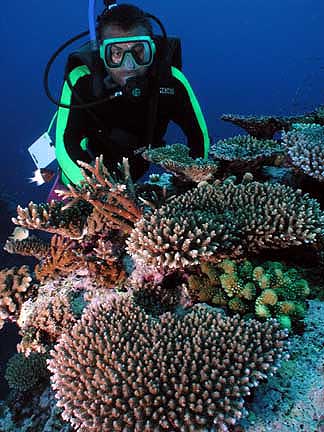 The
same idea applies in Tonga where, thanks to our guests
aboard our Humpback Whale Expeditions, we have delivered
extremely impressive figures to the government about how
much money their small and vulnerable Kingdom is earning
from international tourists coming to see whales alive
versus how much is right now being offered by whaling
interests for licenses to kill those same whales. Sometimes,
simply the presence of a diving vessel in remote areas
such as the reefs we frequent in Fiji, and the attention
it attracts to a rich dynamic habitat, is enough to keep
illegal poachers or indiscriminate long-line fishing boats
at bay. Money talks also in protecting traditional culture.
Our visits to remote villages celebrate historic traditions
and skills that are fast disappearing while earning the
local people money. In some villages, otherwise uninterested
young people, recognizing the value of those customs to
tourists, have actually learned the art of tribal dance
and music (for example) from village elders, thereby ensuring
such heritage is preserved.
The
same idea applies in Tonga where, thanks to our guests
aboard our Humpback Whale Expeditions, we have delivered
extremely impressive figures to the government about how
much money their small and vulnerable Kingdom is earning
from international tourists coming to see whales alive
versus how much is right now being offered by whaling
interests for licenses to kill those same whales. Sometimes,
simply the presence of a diving vessel in remote areas
such as the reefs we frequent in Fiji, and the attention
it attracts to a rich dynamic habitat, is enough to keep
illegal poachers or indiscriminate long-line fishing boats
at bay. Money talks also in protecting traditional culture.
Our visits to remote villages celebrate historic traditions
and skills that are fast disappearing while earning the
local people money. In some villages, otherwise uninterested
young people, recognizing the value of those customs to
tourists, have actually learned the art of tribal dance
and music (for example) from village elders, thereby ensuring
such heritage is preserved.
Etika Rupeni of the World Wide Fund for Nature assists in a reef survey to establish a Marine Protected Area.
In an effort to provide a meaningful and enjoyable eco-tourism experience, NAI'A pursues these projects:
- Ocean Temperature Monitoring at Depth - we set and retrieve recorders and deliver data to the scientist
- Tonga Humpback Whale Expedition - whale watching alongside whale research (surface and under)
- Coral Reef Monitoring - divers can assist cruise director or guest scientists in tracking reef health
- Coral Reef Baseline Surveys - guest scientists lead surveys on board and/or use ship's marine database
- Primal Ocean Project, Phoenix Islands - diving discovery and scientific research expeditions to isolated, Kiribati archipelago
We endeavor to educate and enrich our diving guests by:
- Offering slide seminars or video screenings on local marine life or conservation issues
- Visiting remote villages for casual cultural exchanges and traditional ceremonies
- Encouraging exploratory dives on regular trips or hosting special discovery trips to uncharted territories
We also support local communities and individuals in:
- Payments to traditional "owners" of reef areas we dive
- Sponsorship of community developments in villages
- Employment of an entirely Fijian crew and individual training to higher skills and qualification levels
